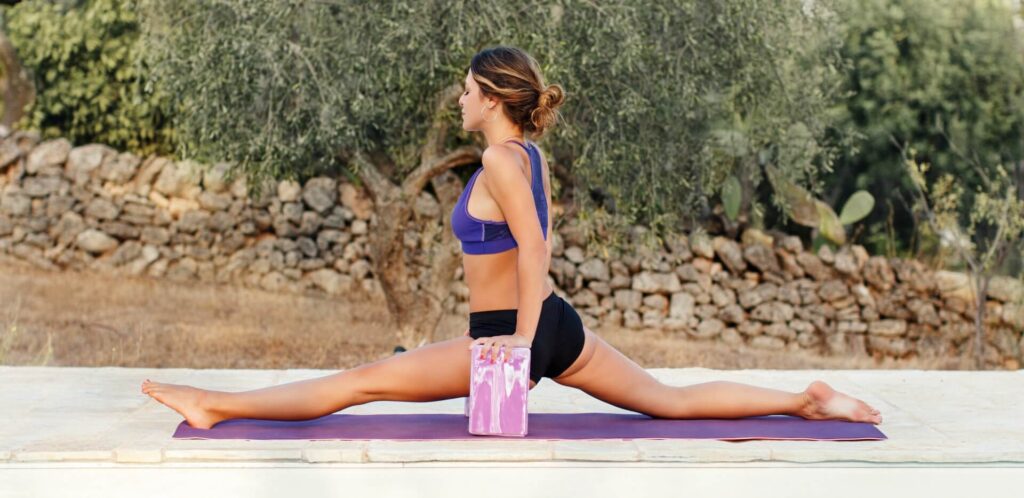Monkey Pose, known as Hanumanasana in Sanskrit, is an advanced yoga posture that honors the legendary leap of Lord Hanuman, who jumped from the southern tip of India to Sri Lanka. This asana requires exceptional flexibility, balance, and dedication. It symbolizes the spirit of overcoming obstacles on an extraordinary journey. In this article, we will explore the origins, symbolism, benefits, and step-by-step instructions for mastering Monkey Pose.
Origin and Symbolism
The name “Hanumanasana” is derived from two Sanskrit words: “Hanuman,” the name of the monkey god in Hindu mythology, and “Asana,” meaning “pose” or “seat.” The pose pays tribute to Hanuman’s remarkable feat of leaping across the ocean to rescue Lord Rama’s wife, Sita. It symbolizes courage, devotion, and determination.
Benefits Monkey Pose
Monkey Pose (Hanumanasana) offers a range of physical and mental benefits:
- Improved Flexibility: This pose demands intense flexibility in the hamstrings, groins, and hip flexors.
- Enhanced Balance: Achieving and maintaining the full expression of Hanumanasana requires balance and stability.
- Strengthened Muscles: It engages and strengthens the muscles of the legs, pelvis, and lower back.
- Hip Opener: Hanumanasana deeply stretches the hip flexors and groin area, improving hip mobility.
- Mental Focus: Practicing this challenging pose cultivates patience, concentration, and resilience.
Step-by-Step Instructions

- Starting Position: Begin in a kneeling position on your yoga mat with your knees hip-width apart.
- Lunge Forward: Take a large step forward with your right foot, extending it straight in front of you.
- Alignment: Ensure that your right foot is aligned with your right hip, keeping the toes pointing forward.
- Engage Core: Engage your core muscles to support your lower back and pelvis.
- Slow Descent: Gradually slide your right heel forward as you extend your leg. Keep your left knee resting on the mat.
- Flex Your Toes: Flex your right foot by pointing the toes toward the ceiling. Maintain an active foot.
- Square Your Hips: Square your hips to the front of your mat, ensuring that both hip points are facing forward.
- Lengthen Spine: Lengthen your spine, keeping your chest lifted and shoulders relaxed.
- Slide Gently: Slide your hands along the mat on either side of your right leg, using your arms for support.
- Hold and Breathe: Hold the pose for 30 seconds to one minute, breathing deeply and mindfully.
- Repeat on the Other Side: To exit the pose, gently slide your right foot back to the starting position and switch sides.
Variations and Modifications
Use yoga props like blocks or cushions under your hips or hamstring to support your practice if your flexibility is limited.
Tips for a Deeper Practice
Focus on maintaining a straight spine and squared hips to deepen the stretch. Practice patience and consistency in your Hanumanasana journey, as progress may take time. Breathe consciously throughout the pose to release tension and find relaxation in the stretch.
Preparation Poses
- Lunges: Practice various lunge poses like Low Lunge (Anjaneyasana) and High Lunge (Crescent Lunge) to improve hip flexibility and prepare your muscles for Hanumanasana.
- Splits Prep: Work on Half Splits (Ardha Hanumanasana) to gradually increase hamstring flexibility and ease into the full split.
- Hip Openers: Poses like Pigeon Pose (Eka Pada Rajakapotasana) and Cow Face Pose (Gomukhasana) can help open and stretch the hip flexors.
- Straddle Stretch: Sit with your legs extended wide apart and reach forward, aiming to increase your leg flexibility and prepare for the wide split.
Counter Poses
- Child’s Pose (Balasana): After practicing Hanumanasana, return to Child’s Pose to release tension in the groin, hips, and hamstrings.
- Cobra Pose (Bhujangasana): Stretch the front of your body with Cobra Pose, which counters the backward leg extension in Hanumanasana.
- Wide-Legged Forward Bend (Prasarita Padottanasana): A wide-legged forward bend helps stretch the hamstrings and provides a balancing stretch after Hanumanasana.
- Reclining Hand-to-Big-Toe Pose (Supta Padangusthasana): Lie on your back, hug one knee toward your chest, and extend the other leg upward, allowing for a gentle hamstring stretch and recovery.
Incorporating these preparation and counter poses into your advanced Hanumanasana practice ensures a balanced and fulfilling yoga session. Always practice mindfully and respect your body’s capabilities and limitations for a safe and enjoyable experience.
Final Thoughts
Monkey Pose (Hanumanasana) stands as a testament to the extraordinary power of yoga, pushing the boundaries of flexibility and balance. It signifies the unwavering dedication and determination required to overcome life’s obstacles. As you practice this advanced pose, embrace the journey, and remember that progress in yoga is a reflection of your commitment and inner strength. Allow Monkey Pose to inspire your practice and life, embodying the spirit of adventure, courage, and resilience.


